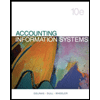The following describes the revenue cycle procedures for a hypothetical company.The sales department clerk receives hard-copy customer orders and manually prepares a six-part hardcopy sales order. Copies of the sales order are distributed to various departments as follows: Copies 1, 2, and 3 go to the shipping department, and Copies 4, 5, and 6 are sent to the billing department where they are temporarily filed by the billing clerk.Upon receipt of the sales order copies, the shipping clerk picks the goods from the warehouse shelves and ships them to the customer. The clerk sends Copy 1 of the sales order along with the goods to the customer. Copy 2 is sent to the billing department, and Copy 3 is filed in the shipping department. When the billing clerk receives Copy 2 from the warehouse, she pulls the other copies from the temporary file and completes the documents by adding prices, taxes, and freight charges. Then, using the department PC, the billing clerk records the sale in the digital Sales Journal, sends Copy 4 (customer bill) to the customer, and sends Copies 5 and 6 to the AR and inventory control departments, respectively.Upon receipt of the documents from the billing clerk, the accounts receivable and inventory control clerks post the transactions to the AR Subsidiary and Inventory Subsidiary ledgers, respectively, using their department PCs. Each clerk then files the respective sales order copies in the department.On the payment due date, the customer sends a check for the full amount and a copy of the bill (the remittance advice) to the company. These documents are received by the mailroom clerk who distributes them as follows:1. The check goes to the cash receipts clerk, who manually records it in the hard-copy cash receipts journal and prepares two deposit slips. One deposit slip and the check are sent to the bank; the other deposit slip is filed in the cash receipts department.2. The remittance advice is sent to the AR clerk, who posts to the digital subsidiary accounts and then files the document.Prepare a data flow diagram and a system flowchart of the revenue cycle procedures previously described.
The following describes the revenue cycle procedures for a hypothetical company.
The sales department clerk receives hard-copy customer orders and manually prepares a six-part hardcopy sales order. Copies of the sales order are distributed to various departments as follows: Copies 1, 2, and 3 go to the shipping department, and Copies 4, 5, and 6 are sent to the billing department where they are temporarily filed by the billing clerk.
Upon receipt of the sales order copies, the shipping clerk picks the goods from the warehouse shelves and ships them to the customer. The clerk sends Copy 1 of the sales order along with the goods to the customer. Copy 2 is sent to the billing department, and Copy 3 is filed in the shipping department. When the billing clerk receives Copy 2 from the warehouse, she pulls the other copies from the temporary file and completes the documents by adding prices, taxes, and freight charges. Then, using the department PC, the billing clerk records the sale in the digital Sales Journal, sends Copy 4 (customer bill) to the customer, and sends Copies 5 and 6 to the AR and inventory control departments, respectively.
Upon receipt of the documents from the billing clerk, the accounts receivable and inventory control clerks
On the payment due date, the customer sends a check for the full amount and a copy of the bill (the remittance advice) to the company. These documents are received by the mailroom clerk who distributes them as follows:
1. The check goes to the cash receipts clerk, who manually records it in the hard-copy cash receipts journal and prepares two deposit slips. One deposit slip and the check are sent to the bank; the other deposit slip is filed in the cash receipts department.
2. The remittance advice is sent to the AR clerk, who posts to the digital subsidiary accounts and then files the document.
Prepare a data flow diagram and a system flowchart of the revenue cycle procedures previously described.
Trending now
This is a popular solution!
Step by step
Solved in 2 steps with 3 images









